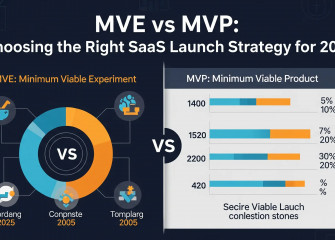eva - A Complete Guide for Startup Product Development
Published by: Abhinav K VDec 04, 2024Blog
In the fast-paced and ever-changing landscape of entrepreneurship, startup product development is a critical step in developing unique ideas into concrete solutions. From ideation to commercialization, each step of this path demands rigorous planning, strategic execution, and unrelenting dedication. In this detailed book, we delve into the complexities of startup product development, explaining each stage and emphasizing the importance of a dependable software development partner. Let us go on this fascinating adventure together.
1. Ideation and Screening
Successful startups begin with a groundbreaking idea. However, not every concept has the ability to succeed in a competitive market. The first stage is brainstorming and screening ideas to find the jewels among them. Here, a software development partner with technical experience is important. By utilizing their knowledge and ideas, they help to assess the project's sustainability, anticipate potential hurdles, and refine the proposal for maximum impact.
2. Concept Validation
After developing an idea, it's crucial to test its practicality and commercial relevance. This phase comprises creating the product's concept and gathering feedback from potential customers. A skilled software development partner assists entrepreneurs in fleshing out the software's features and functionalities, allowing them to picture the finished product and seek useful insights from the target audience.
3. Business Viability Testing
Evaluating an idea's long-term viability is crucial for success. This includes examining marketing plans, analyzing competitors, and determining profitability. A professional development partner provides entrepreneurs with the measurements they need to evaluate the effectiveness of their strategy, find flaws, and fine-tune their approach for best results.
4. UX/UI Design
The design phase aims to create an intuitive user experience, moving from ideation to implementation. In this case, clear communication between entrepreneurs and their development partner is critical. By defining business requirements and matching them with user demands, the software development partner ensures that the design resonates with the intended audience, paving the way for smooth deployment.
5. Minimum Viable Product (MVP) Development
Building a viable product with limited features allows for actionable feedback from early users. This iterative strategy enables entrepreneurs to confirm their assumptions, iterate on their product roadmap, and reduce risks before scaling up. A skilled development partner provides specialized solutions, optimizing development processes to produce a cost-effective MVP within agreed-upon timescales.
6. Test Market Adoption
Understanding customer behavior and preferences is crucial for improving product fit. Analyzing user engagement, detecting feature usage patterns, and iteratively refining the product in response to feedback are all part of test market adoption. The development partner offers entrepreneurs with the tools and data they need to determine user preferences, allowing them to make informed decisions for future iterations.
7. Full-Fledged Product Development and Testing
After MVP testing, entrepreneurs tweak and expand the product with new features. The development partner plays an important role in this phase, overseeing the full development lifecycle, from coding to testing. By assuring extensive testing and quality assurance, they reduce the possibility of defects and technical problems, resulting in a smooth user experience upon release.
8. Product Launch
The product launch marks the completion of an entrepreneur's efforts to introduce their solution to the market. A successful launch demands meticulous preparation and execution, as well as extensive data collecting and analysis. Here, the development partner supports in analyzing user input, monitoring performance indicators, and introducing post-launch changes to encourage user adoption and retention.
9. Commercialization
Maximizing product reach through excellent branding and marketing methods. The development partner helps create monetization models, optimize distribution channels, and improve technical support infrastructure. They enable seamless commercialization and long-term growth by aligning with the business objectives of entrepreneurs.
10. Maintaining competition requires continuous feedback and pricing improvement
The development partner aids with operational cost analysis, pricing strategy evaluation, and market dynamics adaptation. Entrepreneurs may fine-tune their pricing strategy, increase profitability, and assure long-term viability by leveraging data.
Conclusion
To summarize, the journey of startup product creation is riddled with problems and uncertainties, but it is also full of potential for innovation and progress. A dependable software development partner acts as a lighthouse of direction and support, guiding entrepreneurs through the complexities of product development and empowering them to achieve their goals. As organizations in the United States and Canada embark on their entrepreneurial journeys, partnering with experienced software development firms in the region can be pivotal for success. These firms offer specialized expertise and resources tailored to the unique needs of startups, ensuring seamless product development and long-term market relevance. With a deep understanding of local market dynamics, regulatory requirements, and access to a diverse talent pool, software development companies in the US and Canada facilitate effective collaboration, innovation, and growth. Leveraging their technical prowess and industry insights, startups can navigate the complexities of product development, capitalize on emerging opportunities, and establish a competitive edge in today's dynamic business landscape.



 ColdFusion Development Tips fo....
ColdFusion Development Tips fo....
 Why Upgrade to Adobe ColdFusio....
Why Upgrade to Adobe ColdFusio....
 AI Prompting Tips That Improve....
AI Prompting Tips That Improve....
 Adobe ColdFusion 2025: Enginee....
Adobe ColdFusion 2025: Enginee....
 You Don’t Need Just Code, Yo....
You Don’t Need Just Code, Yo....



Your Trusted Software Development Company